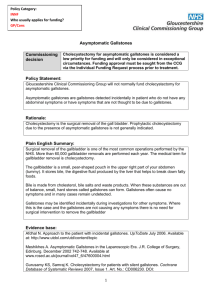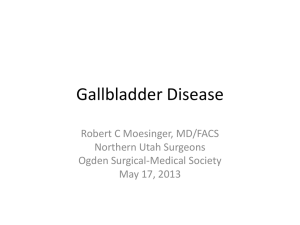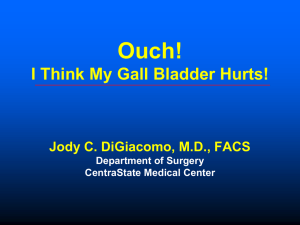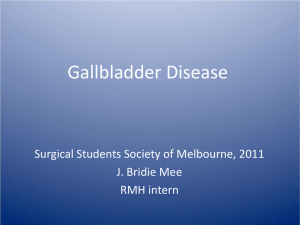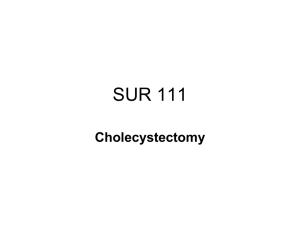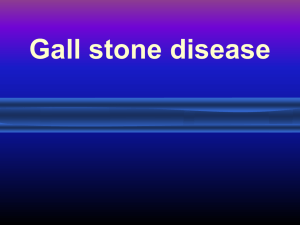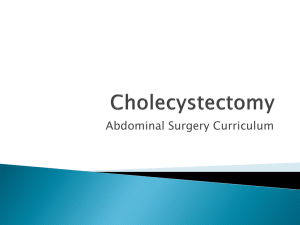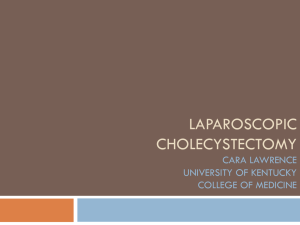Bedfordshire and Hertfordshire Priorities Forum Title: Revision of
advertisement
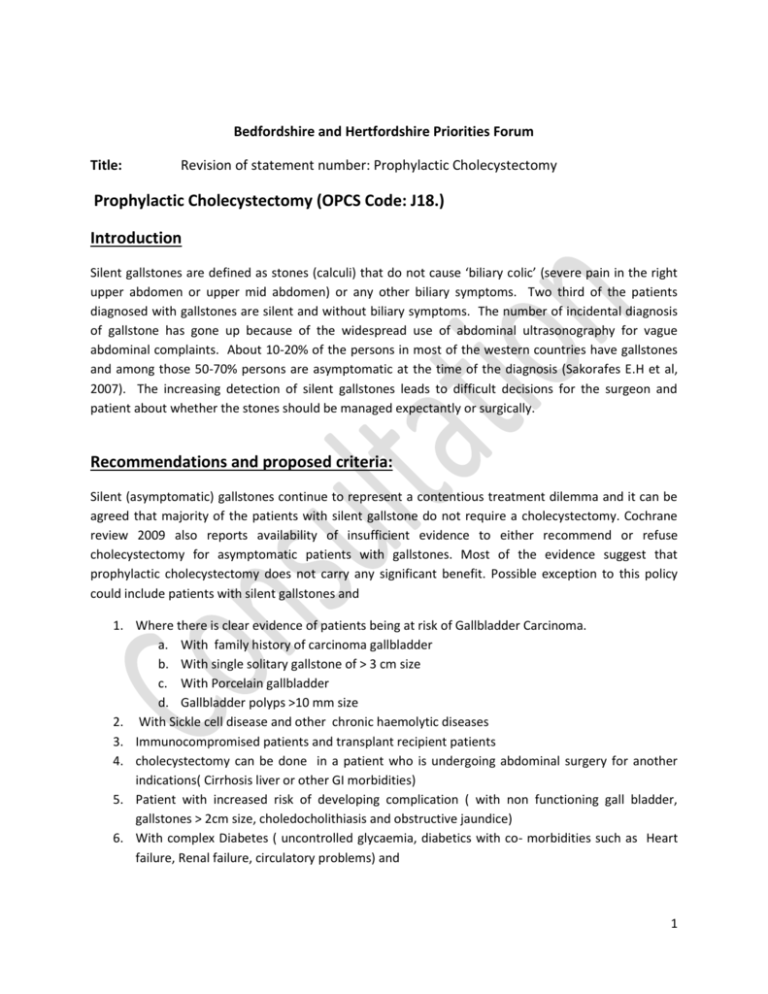
Bedfordshire and Hertfordshire Priorities Forum Title: Revision of statement number: Prophylactic Cholecystectomy Prophylactic Cholecystectomy (OPCS Code: J18.) Introduction Silent gallstones are defined as stones (calculi) that do not cause ‘biliary colic’ (severe pain in the right upper abdomen or upper mid abdomen) or any other biliary symptoms. Two third of the patients diagnosed with gallstones are silent and without biliary symptoms. The number of incidental diagnosis of gallstone has gone up because of the widespread use of abdominal ultrasonography for vague abdominal complaints. About 10-20% of the persons in most of the western countries have gallstones and among those 50-70% persons are asymptomatic at the time of the diagnosis (Sakorafes E.H et al, 2007). The increasing detection of silent gallstones leads to difficult decisions for the surgeon and patient about whether the stones should be managed expectantly or surgically. Recommendations and proposed criteria: Silent (asymptomatic) gallstones continue to represent a contentious treatment dilemma and it can be agreed that majority of the patients with silent gallstone do not require a cholecystectomy. Cochrane review 2009 also reports availability of insufficient evidence to either recommend or refuse cholecystectomy for asymptomatic patients with gallstones. Most of the evidence suggest that prophylactic cholecystectomy does not carry any significant benefit. Possible exception to this policy could include patients with silent gallstones and 1. Where there is clear evidence of patients being at risk of Gallbladder Carcinoma. a. With family history of carcinoma gallbladder b. With single solitary gallstone of > 3 cm size c. With Porcelain gallbladder d. Gallbladder polyps >10 mm size 2. With Sickle cell disease and other chronic haemolytic diseases 3. Immunocompromised patients and transplant recipient patients 4. cholecystectomy can be done in a patient who is undergoing abdominal surgery for another indications( Cirrhosis liver or other GI morbidities) 5. Patient with increased risk of developing complication ( with non functioning gall bladder, gallstones > 2cm size, choledocholithiasis and obstructive jaundice) 6. With complex Diabetes ( uncontrolled glycaemia, diabetics with co- morbidities such as Heart failure, Renal failure, circulatory problems) and 1 Appendix 1 Review of Evidence Cholecystectomy, a surgical procedure to remove gallbladder is the gold standard treatment for symptomatic gallstones; natural history of the silent (asymptomatic) gallstone is not known adequately to recommend a definitive treatment strategy for such patients. This review examines the evidence currently available upon which such decision must be based. Gallstones may present as biliary pain, acute cholecystitis, biliary obstruction and jaundice, acute cholangitis or acute pancreatitis but it is not clear who will develop these symptoms. Studies of the natural history of silent (asymptomatic) gallstone suggest that a large majority of patients (2/3rd ) remain symptom free and cumulative probability of developing biliary colic after 10 years ranges from 15-25% (Gupta SK, et al). Halldestam I, et al 2004; did not find any significant differences between treated and untreated patients with regards to digestive symptoms or any other risk factors. They also suggested that cumulative risk of needing a treatment during first five years after detection of silent gallstone is 7.6% Persons with Diabetes mellitus are at increased risk (Gibney EJ); diabetes causes higher incidence of acute inflammation of pancreas and jaundice, it also aggravates fatty changes in the liver. Persons with complicated diabetes are better managed with an elective surgery (Schwesinger W.H, et al). Patients who are found to have a solitary large gallstone (> 3cm in diameter) occupying the entire lumen of the gallbladder (Baillie. John), porcelain gallbladder (Stephen AE et al 2001) and gall bladder polyps greater than 10 mm in size (Diehl AK, 1983) are at increased risk for gallbladder carcinoma; therefore, prophylactic cholecystectomy will reduce the risk. A study conducted by (Castaing D, et al) suggested that 78% of the Cirrhotic patients with gallstone were silent and 20% of these died from liver failure. Their results confirm the high incidence of cholelithiaisis in patients with cirrhosis liver; complications of gallstones were not frequent but requirement of an emergency surgery carried high risk in these patients. On the other hand elective surgical procedure at the time of portal diversion does not bear any peculiar risk. A patient with a major organ transplant is more likely to become symptomatic within 2 years of the transplantation (Sakorafes D, et al 2007) and the diagnosis of the complications of cholelithiasis is difficult in immunocompromised patients (Kao LS, et al 2003). Study also recommended cholecystectomy in patients awaiting transplantation and also who are immunocompromised. Persons with Chronic Haemolytic syndrome are at increased risk of developing gallstones and early gallstones raises the risk of lifetime biliary complications and these complications are difficult to distinguish with ‘vaso-occlusive crisis’ (Sakorafes D, et al 2007). Hence cholecystectomy would be beneficial in these patients. Brian John suggested that patients with no other risk factors but who are going to be living or travelling for a long period of time in a location that is far from basic medical care should be offered prophylactic 2 cholecystectomy because recurrent symptomatic attack may lead to severe complications and clinical syndromes (necrotising pancreatitis). The natural history of silent gallstone in children is not known although agreement has emerged to support cholecystectomy for all calcific non-resolving gallstones in children (Chan. S, et al) A paper by the “world Gastroenterology organisation” concludes that cholecystectomy in an asymptomatic gallstones confers no benefit to the patients, even in patients with one attack of biliary colic. The risks of surgery outweigh the complications of gallstones. Operative mortality of elective cholecystectomy is 0.5% and risk increases in elderly, patients > 60 yrs of age (Gupta SK et al) and complications in the elective surgery are high and at the rate of 17% for all surgical techniques ( Keus F, et al, 2008) Impact Assessment: There were 271 Cholecystectomies procedures performed on the patients of NHS Bedfordshire in the year 2009_2010. Out of which 242 cholecystectomy procedures were performed on patients with the primary diagnosis of cholelithiasis. A snapshot cost evaluation has been done using HES data of NHS Bedfordshire cholecystectomies without cholecystitis (HRG 4) performed on cholelithiasis (K80) in the year 2009_2010; 242 cases with primary diagnosis of cholelithiasis incurred a cost of £ 402030. On further analysis, it was observed that there were 129 cases with a code of K802 signifying cholecystectomy without any previous history of cholecystitis (acute, chronic or non specific cholecystitis) which had incurred a cost of £ 203059 and 16 cases of cholecystectomies performed in cases of bile duct calculus without cholangitis or cholecystitis (K805), costing NHS Bedfordshire a price of £29,293.00. Similar figures can be expected in other health economies. Table1 below gives further elaboration of cholecystectomy case on other indications. The suggested guidelines for prophylactic cholecystectomy might be expected to reduce activity by around 50%; this would represent approximately 145 fewer cases per annum, at a financial saving of around £232000(assumption based on local HES data_09_10) The changes proposed will not increase health inequalities. Prophylactic cholecystectomy will continue to be solely on the basis of clinical need. Moreover, disinvestment will allow us to mobilise the saving on other services, which might otherwise have had a negative effect on health inequalities. Table1 showing break down of cost incurred due to cholecystectomies performed on various clinical indications 3 Procedures and Diagnosis with HES codes Number of cases Cost incurred to NHS Bedfordshire Cholecystectomy without cholecystitis ( K80, K81) 271 £446,211.00 Cholecystectomy without cholecystitis ( K80, K81) with primary diagnosis of Cholelithiasis 242 £402,030.00 Cholecystectomy without cholecystis ( K802 = No H/O acute/chronic or any other cholecystis) 129 £203,059.00 Cholecystectomy in calculus of bileduct without cholacystitis and cholengitis (K805) 16 £29,293.00 Cholecystectomy without cholecystitis but with previous H/O Chronic cholecystitis(K811 17 £26,227.00 Cholecystectomy without cholecystitis but with previous H/O acute cholecystitis (K810) 5 £7,548.00 Cholecystectomy without cholecystitis but with previous H/O nonspecific cholecystitis (K819) 4 £6,048.00 Cholecystectomy without cholecystitis but with other diseases of Gallbladder (K828,K829) 33 £52,645.00 Cholecystectomy without cholecystitis but with Diabetes 8 £12,041.00 Cholecystectomy without cholecystitis done with other abdominal surgery ( primary procedure umbilical hernia) 10 £13,744.00 Cholecystectomy without cholecystitis done with family or personal H/O malignancy 3 £4,437.00 Cholecystectomy without cholecystitis with acute pancreatitis(K85X) 1 £1,496.00 Cholecystectomy without cholecystitis with other diseases of peritoneum(K828) 1 £1,496.00 Cholecystectomy without cholecystitis during hepato-biliary procedure 5 £24,697.00 Reduction in activity= (129+16)/242*100=59.92% Saving= £203059+£29293= £232352 ( apr two hundred and thirty thousand and three fifty two pounds) (Source: HES through CIU, NHS Bedfordshire) References: 1. Gurusamy KS, Samraj K. Cholecystectomy for patients with silent gallstones. Cochrane Database of Systematic Reviews 2007, Issue 1. Art. No.: CD006230. DOI: 10.1002/14651858.CD006230.pub2. 2. Halldestam I, Enell EL, Kullman E, Borch K. Development of symptoms and complications in individuals with asymptomatic gallstones. British Journal of Surgery. 2004;91(6):734-8. 4 3. Keus F, Gooszen HG, van Laarhoven CJHM. Open, small-incision, or laparoscopic cholecystectomy for patients with symptomatic cholecystolithiasis. An overview of Cochrane Hepato-Biliary Group reviews. Cochrane Database of Systematic Reviews 2010, Issue 1. Art. No.: CD008318. DOI: 10.1002/14651858.CD008318. 4. Gurusamy KS, Samraj K. Cholecystectomy for patients with silent gallstones. Cochrane Database of Systematic Reviews 2007, Issue 1. Art. No.: CD006230. DOI: 10.1002/14651858.CD006230.pub2. 5. Sakorafas, G. H. Milingos, D. Peros, G. Asymptomatic Cholelithiasis: Is Cholecystectomy Really Needed? A Critical Reappraisal 15 Years After the Introduction of Laparoscopic Cholecystectomy. DIGESTIVE DISEASES AND SCIENCES 2007, VOL 52; NUMBER 5, pages 13131325 6. Gupta SK, Shukla VK. Silent gallstones: a therapeutic dilemma.Trop Gastroenterol 2004 AprJun;25(2):65-8 - PubTypeList: Journal Article, Review. 7. Gibney EJ. Asymptomatic gallstones. British journal of surgery 1990 vol 77, issue 4, pg 368-372 8. Schwesinger WH, Diehl AK. Changing indications for laparoscopic cholecystectomy. Stones without symptoms and symptoms without stones. Surg Clin North AM. 1996 Jun; 76(3):493-504. 9. Chan S, Currie J, Malik AI, Mahomed AA. Paediatric cholecystectomy: Shifting goalposts in the laparoscopic era. Surg Endosc. 2008 May;22(5):1392-5. 10. Halldestam I, Enell EL, Kullman E, Borch K. Development of symptoms and complications in individuals with asymptomatic gallstones. Br J Surg. 2004 Jun;91(6):734-8. 11. Castaing D, Houssin D, Lemoine J, Bismuth H. Surgical management of gallstones in cirrhotic patients. Am J Surg. 1983 Sep;146(3):310-3 12. The NHS Information Centre, Hospital Episode Statistics for England. Inpatient statistics, 200910. (http://www.hesonline.nhs.uk) 5 Bibliography: 1. NICE: http://www.nice.org.uk/nicemedia/live/12237/48780/48780.pdf 2. World Gastroenterology Organisation: http://www.worldgastroenterology.org/assets/downloads/en/pdf/guidelines/10_gallsto ne_en.pdf 3. [Guidelines of the German Society of Gastroenterology for the treatment of gallstone] Sauerbruch T, Z Arztl Fortbild Qualitatssich. 2002 May;96(4):222-6 - PubTypeList: Journal Article 4. Gallstone policy (accessed online on 27/06/2011) http://www.westminster.nhs.uk/English/about-us/northwestlondon/aboutus/Documents/33%20-%20Gallstones.pdf 5. Laparoscopic Cholecystectomy for Asymptomatic Gall Stones: (accessed online on 27/06/2011)http://www.northsomersetpathways.co.uk/documents/funding/general_su rgery/LaparoscopiccholecystectomyPolicy.pdf 6. Asymptomatic gallstone: http://www.suffolk.nhs.uk/Home/AboutUs/Makingdecisionsonfundingtreatments/tabid /303/Default.aspx Appendix 1: Draft guideline for prophylactic cholecystectomy Copy of Draft_Guideline_PDF.pdf 6 7
